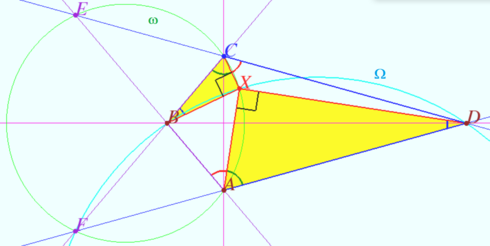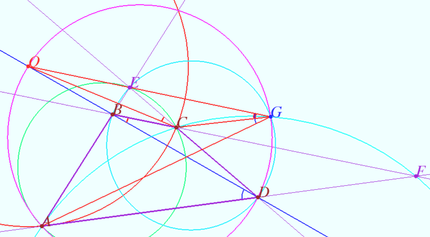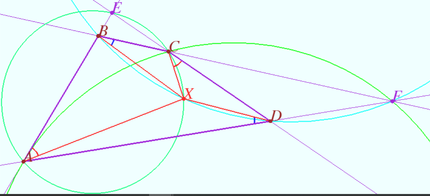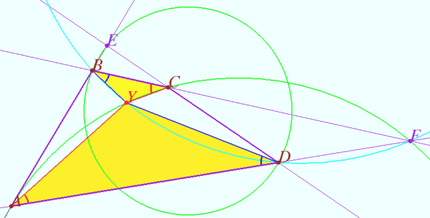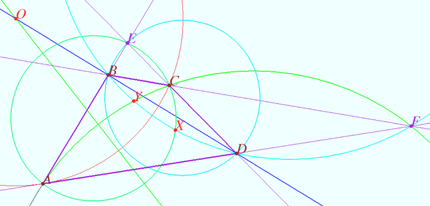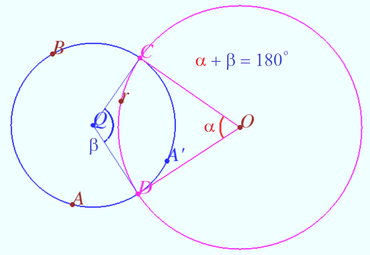Difference between revisions of "2018 IMO Problems/Problem 6"
(→Solution) |
(→Solution) |
||
| Line 6: | Line 6: | ||
==Solution== | ==Solution== | ||
[[File:2018 IMO 6.png|490px|right]] | [[File:2018 IMO 6.png|490px|right]] | ||
| − | |||
<i><b>Special case</b></i> | <i><b>Special case</b></i> | ||
| Line 16: | Line 15: | ||
Let <math>E</math> and <math>F</math> be the intersection points of <math>AB</math> and <math>CD,</math> and <math>BC</math> and <math>DA,</math> respectively. | Let <math>E</math> and <math>F</math> be the intersection points of <math>AB</math> and <math>CD,</math> and <math>BC</math> and <math>DA,</math> respectively. | ||
| − | The points <math>B</math> and <math>D</math> are symmetric with respect to the circle <math>\omega = | + | The points <math>B</math> and <math>D</math> are symmetric with respect to the circle <math>\omega = ACEF</math> <i><b>(Claim 1).</b></i> |
The circle <math>\Omega = FBD</math> is orthogonal to the circle <math>\omega</math> <i><b>(Claim 2).</b></i> | The circle <math>\Omega = FBD</math> is orthogonal to the circle <math>\omega</math> <i><b>(Claim 2).</b></i> | ||
Let <math>X_0</math> be the point of intersection of the circles <math>\omega</math> and <math>\Omega.</math> | Let <math>X_0</math> be the point of intersection of the circles <math>\omega</math> and <math>\Omega.</math> | ||
| − | Quadrilateral <math>AX_0CF</math> is cyclic <math>\implies</math> <cmath>\angle X_0AB = \frac { | + | Quadrilateral <math>AX_0CF</math> is cyclic <math>\implies</math> <cmath>\angle X_0AB = \frac {\overset{\Large\frown} {X_0CE}}{2} = \frac {360^\circ -\overset{\Large\frown} {X_0AFE}}{2} = 180^\circ - \angle X_0CE = \angle X_0CD.</cmath> |
Similarly, quadrangle <math>DX_0BF</math> is cyclic <math>\implies \angle X_0BC = \angle X_0DA</math>. | Similarly, quadrangle <math>DX_0BF</math> is cyclic <math>\implies \angle X_0BC = \angle X_0DA</math>. | ||
| Line 27: | Line 26: | ||
This means that point <math>X_0</math> coincides with the point <math>X</math>. | This means that point <math>X_0</math> coincides with the point <math>X</math>. | ||
| − | <math>\hspace{10mm} \angle FCX = \angle BCX = \frac { | + | <math>\hspace{10mm} \angle FCX = \angle BCX = \frac {\overset{\Large\frown} {XAF}}{2}</math> of <math>\omega.</math> |
| − | <math>\hspace{10mm} \angle CBX = \angle XDA = \frac { | + | <math>\hspace{10mm} \angle CBX = \angle XDA = \frac {\overset{\Large\frown} {XBF}}{2}</math> of <math>\Omega.</math> |
The sum <math>\overset{\Large\frown} {XAF} + \overset{\Large\frown} {XBF} = 180^\circ</math> <i><b>(Claim 3)</b></i> <math>\implies</math> | The sum <math>\overset{\Large\frown} {XAF} + \overset{\Large\frown} {XBF} = 180^\circ</math> <i><b>(Claim 3)</b></i> <math>\implies</math> | ||
| Line 35: | Line 34: | ||
<math>\angle XCB + \angle XBC = 90^\circ \implies \angle CXB = 90^\circ.</math> | <math>\angle XCB + \angle XBC = 90^\circ \implies \angle CXB = 90^\circ.</math> | ||
| − | Similarly, <math>\angle AXD = 90^\circ \implies \angle BXA + \angle DXC = | + | Similarly, <math>\angle AXD = 90^\circ \implies \angle BXA + \angle DXC = 360^\circ -\angle AXD -\angle CXB = 180^\circ.</math> |
| − | |||
| − | |||
| − | |||
| − | |||
| − | |||
| − | |||
| − | |||
[[File:2018 IMO 6a.png|430px|right]] | [[File:2018 IMO 6a.png|430px|right]] | ||
| Line 48: | Line 40: | ||
[[File:2018 IMO 6c.png|430px|right]] | [[File:2018 IMO 6c.png|430px|right]] | ||
[[File:2018 IMO 6d.png|430px|right]] | [[File:2018 IMO 6d.png|430px|right]] | ||
| + | [[File:2018 IMO 6 Claim 3.png|370px|right]] | ||
<i><b>Common case </b></i> | <i><b>Common case </b></i> | ||
| Line 89: | Line 82: | ||
We make transformation and get <cmath>{\sin \psi} = \frac {CD}{DX} {\sin \alpha} = \frac{CD}{DX} \cdot {\frac{DX \cdot AB}{BX \cdot CD}} {\sin \alpha} = \frac {AB}{BX}\sin \alpha = \sin \psi.</cmath> | We make transformation and get <cmath>{\sin \psi} = \frac {CD}{DX} {\sin \alpha} = \frac{CD}{DX} \cdot {\frac{DX \cdot AB}{BX \cdot CD}} {\sin \alpha} = \frac {AB}{BX}\sin \alpha = \sin \psi.</cmath> | ||
| + | |||
| + | |||
| + | <i><b>Claim 1</b></i> Let <math>A, C,</math> and <math>E</math> be arbitrary points on a circle <math>\omega, l</math> be the perpendicular bisector to the segment <math>AC.</math> Then the straight lines <math>AE</math> and <math>CE</math> intersect <math>l</math> at the points <math>B</math> and <math>D,</math> symmetric with respect to <math>\omega.</math> | ||
| + | |||
| + | <i><b>Claim 2</b></i> Let points <math>B</math> and <math>D</math> be symmetric with respect to the circle <math>\omega.</math> Then any circle <math>\Omega</math> passing through these points is orthogonal to <math>\omega.</math> | ||
| + | |||
| + | <i><b>Claim 3</b></i> The sum of the arcs between the points of intersection of two perpendicular circles is <math>180^\circ.</math> | ||
| + | In the figure they are a blue and red arcs <math>\overset{\Large\frown} {CD}, \alpha + \beta = 180^\circ.</math> | ||
Revision as of 10:13, 19 August 2022
A convex quadrilateral ![]() satisfies
satisfies ![]() Point
Point ![]() lies inside
lies inside
![]() so that
so that
![]() and
and ![]() Prove that
Prove that ![]()
Solution
Special case
We construct point ![]() and prove that
and prove that ![]() coincides with the point
coincides with the point ![]()
Let ![]() and
and ![]()
Let ![]() and
and ![]() be the intersection points of
be the intersection points of ![]() and
and ![]() and
and ![]() and
and ![]() respectively.
respectively.
The points ![]() and
and ![]() are symmetric with respect to the circle
are symmetric with respect to the circle ![]() (Claim 1).
(Claim 1).
The circle ![]() is orthogonal to the circle
is orthogonal to the circle ![]() (Claim 2).
(Claim 2).
Let ![]() be the point of intersection of the circles
be the point of intersection of the circles ![]() and
and ![]() Quadrilateral
Quadrilateral ![]() is cyclic
is cyclic ![]()
![]()
Similarly, quadrangle ![]() is cyclic
is cyclic ![]() .
.
This means that point ![]() coincides with the point
coincides with the point ![]() .
.
![]() of
of ![]()
![]() of
of ![]()
The sum ![]() (Claim 3)
(Claim 3) ![]()
![]()
Similarly, ![]()
Common case
Denote by ![]() the intersection point of the perpendicular bisector of
the intersection point of the perpendicular bisector of ![]() and
and ![]() Let
Let ![]() be a circle (red) with center
be a circle (red) with center ![]() and radius
and radius ![]()
The points ![]() and
and ![]() are symmetric with respect to the circle
are symmetric with respect to the circle ![]() (Claim 1).
(Claim 1).
The circles ![]() and
and ![]() are orthogonal to the circle
are orthogonal to the circle ![]() (Claim 2).
(Claim 2).
Circles ![]() and
and ![]() are symmetric with respect to the circle
are symmetric with respect to the circle ![]() (Lemma).
(Lemma).
Denote by ![]() the point of intersection of the circles
the point of intersection of the circles ![]() and
and ![]() Quadrangle
Quadrangle ![]() is cyclic
is cyclic ![]() (see Special case).
Similarly, quadrangle
(see Special case).
Similarly, quadrangle ![]() is cyclic
is cyclic ![]()
The required point ![]() is constructed.
is constructed.
Denote by ![]() the point of intersection of circles
the point of intersection of circles ![]() and
and ![]()
Quadrangle ![]() is cyclic
is cyclic ![]()
Quadrangle ![]() is cyclic
is cyclic ![]()
The triangles ![]() by two angles, so
by two angles, so ![]()
The points ![]() and
and ![]() are symmetric with respect to the circle
are symmetric with respect to the circle ![]() , since they lie on the intersection of the circles
, since they lie on the intersection of the circles ![]() and
and ![]() symmetric with respect to
symmetric with respect to ![]() and the orthogonal
and the orthogonal ![]() circle
circle ![]()
The point ![]() is symmetric to itself, the point
is symmetric to itself, the point ![]() is symmetric to
is symmetric to ![]() with respect to
with respect to ![]() Usung
Usung ![]() and the equality
and the equality ![]() we get
we get ![]() The point
The point ![]() is symmetric to itself, the point
is symmetric to itself, the point ![]() is symmetric to
is symmetric to ![]() with respect to
with respect to ![]()
![]()
![]() The point
The point ![]() is symmetric to
is symmetric to ![]() and the point
and the point ![]() is symmetric to
is symmetric to ![]() with respect to
with respect to ![]() hence
hence
![]()
![]() Denote
Denote ![]()
By the law of sines for ![]() we obtain
we obtain ![]()
By the law of sines for ![]() we obtain
we obtain ![]()
We make transformation and get ![]()
Claim 1 Let ![]() and
and ![]() be arbitrary points on a circle
be arbitrary points on a circle ![]() be the perpendicular bisector to the segment
be the perpendicular bisector to the segment ![]() Then the straight lines
Then the straight lines ![]() and
and ![]() intersect
intersect ![]() at the points
at the points ![]() and
and ![]() symmetric with respect to
symmetric with respect to ![]()
Claim 2 Let points ![]() and
and ![]() be symmetric with respect to the circle
be symmetric with respect to the circle ![]() Then any circle
Then any circle ![]() passing through these points is orthogonal to
passing through these points is orthogonal to ![]()
Claim 3 The sum of the arcs between the points of intersection of two perpendicular circles is ![]() In the figure they are a blue and red arcs
In the figure they are a blue and red arcs ![]()





